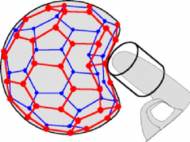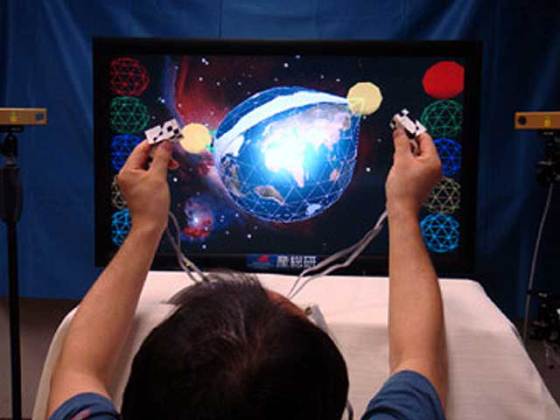Interface from AIST enables you to touch virtual 3D images
 Japan’s National Institute of Advanced Industrial Science and Technology (AIST) announced the i3Space – a system that provides a feeling of touch when users interact with a 3D image. Unlike the Airborne Ultrasound Tactile Display we described in one of our previous articles, the i3Space recognizes the movement of fingers and coordinates the Virtual Reality (VR) content with a multi-position tracking system and tactile providing interface.
Japan’s National Institute of Advanced Industrial Science and Technology (AIST) announced the i3Space – a system that provides a feeling of touch when users interact with a 3D image. Unlike the Airborne Ultrasound Tactile Display we described in one of our previous articles, the i3Space recognizes the movement of fingers and coordinates the Virtual Reality (VR) content with a multi-position tracking system and tactile providing interface.
This system is used to simulate a response of virtual objects by providing a sense of touch and texture, as well as the feedback of forces that could occur in the virtual world. The i3Space recognizes the movement of fingers and controls a tactile sense and a kinesthetic sense (resistance) in real time in accordance with the movement to offer a feeling of touching a 3D image.
The real-time VR space creation system calculates the virtual force being applied to a 3D image from the movement of the user and the positions of fingers. Then, it generates reaction forces and modifies the 3D image accordingly. It conducts a series of processes to create responses to the user’s movement in real time.
The illusionary tactile and kinesthetic sense interface consists of the illusionary tactile and kinesthetic sense device which offers tactile and kinesthetic senses, and the illusionary tactile and kinesthetic sense controller which is a control circuit for the device. AIST used the GyroCubeSensuous, which was developed in 2005 and miniaturized in 2007, for the illusionary tactile and kinesthetic sense device.
The multi-position tracker system locates the position of a marker attached to a fingertip by surrounding the user with several cameras. Multiple cameras are used in order to track the position of the marker attached to the fingertips, and the system uses more than one camera in order to eliminate potential blind spots the user may create.
Researchers from AIST envision that the i3Space will be used for simulations (i.e. medical operations), game interfaces and in design. The design feature is pretty interesting since it offers the opportunity to hold the prototypes made in some 3D modeling program a without the usage of rapid prototyping machines. The researchers also mentioned a virtual pottery wheel as an implementation of their technology, where you could feel the rotating clay while you create various objects.
In the further development of the system, the folks from AIST intend to reduce its size, enhance its functions and collaborate with device makers in development and field tests. AIST will announce the details of the i3Space at CEDEC 2010, a conference for game developers that will take place from Aug 31 to Sept 2, 2010, in Yokohama City, Japan.










Leave your response!